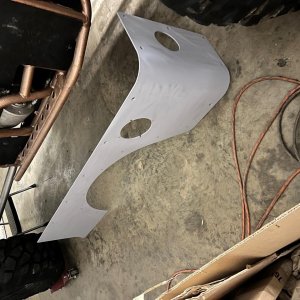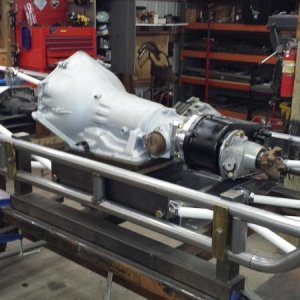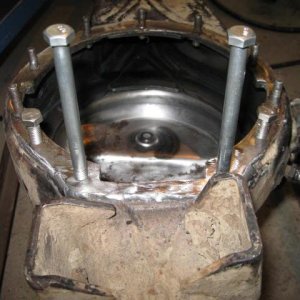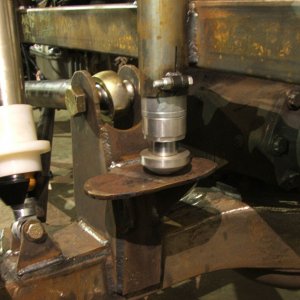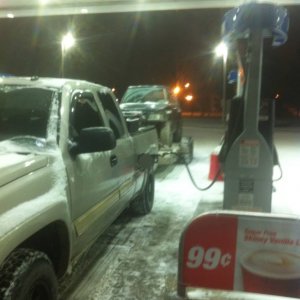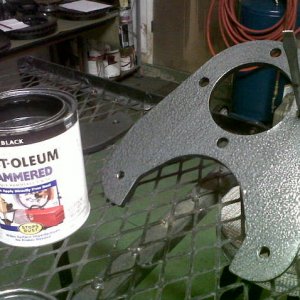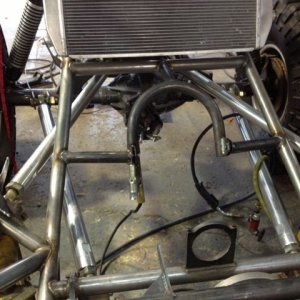Also make sure the people in your group know how to get the extinguisher off your rig. We had a incident this year when a buddies rig had a small fire. I was standing right next to it when it went up. Grabbed the pin to release the fire extinguisher and could not get it off the mount. It had to be pulled up and over and I had no clue. Mounting them under the seat probably is not gonna help in a emergency situation make sure there easy (like 2nd nature) to get to.
-
Help Support Hardline Crawlers :
You are using an out of date browser. It may not display this or other websites correctly.
You should upgrade or use an alternative browser.
You should upgrade or use an alternative browser.
Fires!
- Thread starter al1tonyota
- Start date
John Galbreath Jr.
38 Special & Solo Buggy
- Joined
- May 24, 2007
- Messages
- 8,613
Trying to get my head wrapped around the best "product" for our application.
From this page: http://www.ioportracing.com/faq/fire.htm
What are the differences between extinguishing agents?
Halon 1211: Advantages are that it leaves no residue, effective, not thermal shocking and the bottle withstands higher cockpit heat compared to Halon 1301. Disadvantages are that it is toxic, does not quench the fire and is Ozone depleting. This chemical was not designed for system use as it is toxic, designed for hand held fire extinguishers only. This is one of two chemicals used by FireBottle (the other being CEA-614). Safecraft offers this chemical for high-heat installations. We recommend Halon 1211 when the bottle is placed over exhaust systems or stored in an area where the bottle will be subjected to sustained temperatures at or above 130º F.
CEA-614: This is a Halon substitute. Advantages are that it leaves no residue, not thermal shocking, and relatively Ozone safe. Disadvantages are that it does not quench the fire and it takes twice as much material to do the same job as Halon. It is also expensive. Although 5# of CEA-614 may be legal for use in the SCCA, it will not do the same job as 5# of Halon. This agent is not used very much anymore.
FE-36: This new agent is a Halon substitute. It is not considered Ozone-depleting. It is used by Safecraft in their SFI-certified systems. It leaves no residue and is not thermal shocking. Disadvantages are the same as CEA-614: it does not quench the fire and it takes twice as much material to do the same job as Halon. It is also more expensive than Halon. The SCCA now requires an SFI-certified system in all new cars. If this is what you need, either choose this agent, or the ESS system with AFFF.
AFFF or ColdFire: These are examples of foaming water-based systems. Advantages are that it quenches the fire. Disadvantages are that systems are heavier, will not spread out like Halon, leaves a mess both in the car and on the track. If you would like this agent, we provide ESS brand systems using AFFF.
Halon 1301: In my opinion, the best product on the market. Advantages are that it is effective, non-toxic, non-caustic, leave no residue, small, lightweight, industry standard with plenty of supply, no thermal shock, leaves no mess. Disadvantages are that it does not quench the fire and it is Ozone depleting.
So, based on this. AFFF or ColdFire would be a better product for us than Halon. Is that correct? I have head only good stuff about Halon and that is what I carry in the Single Seater.
From this page: http://www.ioportracing.com/faq/fire.htm
What are the differences between extinguishing agents?
Halon 1211: Advantages are that it leaves no residue, effective, not thermal shocking and the bottle withstands higher cockpit heat compared to Halon 1301. Disadvantages are that it is toxic, does not quench the fire and is Ozone depleting. This chemical was not designed for system use as it is toxic, designed for hand held fire extinguishers only. This is one of two chemicals used by FireBottle (the other being CEA-614). Safecraft offers this chemical for high-heat installations. We recommend Halon 1211 when the bottle is placed over exhaust systems or stored in an area where the bottle will be subjected to sustained temperatures at or above 130º F.
CEA-614: This is a Halon substitute. Advantages are that it leaves no residue, not thermal shocking, and relatively Ozone safe. Disadvantages are that it does not quench the fire and it takes twice as much material to do the same job as Halon. It is also expensive. Although 5# of CEA-614 may be legal for use in the SCCA, it will not do the same job as 5# of Halon. This agent is not used very much anymore.
FE-36: This new agent is a Halon substitute. It is not considered Ozone-depleting. It is used by Safecraft in their SFI-certified systems. It leaves no residue and is not thermal shocking. Disadvantages are the same as CEA-614: it does not quench the fire and it takes twice as much material to do the same job as Halon. It is also more expensive than Halon. The SCCA now requires an SFI-certified system in all new cars. If this is what you need, either choose this agent, or the ESS system with AFFF.
AFFF or ColdFire: These are examples of foaming water-based systems. Advantages are that it quenches the fire. Disadvantages are that systems are heavier, will not spread out like Halon, leaves a mess both in the car and on the track. If you would like this agent, we provide ESS brand systems using AFFF.
Halon 1301: In my opinion, the best product on the market. Advantages are that it is effective, non-toxic, non-caustic, leave no residue, small, lightweight, industry standard with plenty of supply, no thermal shock, leaves no mess. Disadvantages are that it does not quench the fire and it is Ozone depleting.
So, based on this. AFFF or ColdFire would be a better product for us than Halon. Is that correct? I have head only good stuff about Halon and that is what I carry in the Single Seater.
blacksheep10
XBJRA champ/ 555 and team Nasty codriver
Same as ORS, our quickest mount is in the vendor area:
http://www.hardlinecrawlers.com/forums/index.php?topic=21272.0
I only have 1 on my buggy, and obviously need a couple more plus something underhood. Scary as ****.
I like JJ's idea of the one routed to the engine compartment
http://www.hardlinecrawlers.com/forums/index.php?topic=21272.0
I only have 1 on my buggy, and obviously need a couple more plus something underhood. Scary as ****.
I like JJ's idea of the one routed to the engine compartment
patooyee
Well-Known Member
- Joined
- Sep 27, 2008
- Messages
- 5,692
I used Halon mainly because its what I had space for and could afford. But the coldfire stuff only extinguishes what it comes into contact with whereas Halon almost sucks the air out of the entire area. (If you've ever tried to breath anywhere Halon has been sprayed you know what I mean.)
I've had the misfortune of using both on various insundry fires around work / the house and you have to get the liquid directly on the base of the flame or it keeps burning. BUT the liquid stays in place, so for stuff like dripping / leaking oil that keeps leaking on your hot headers it tends to keep the flame from re-igniting. Halon won't do that, but it is like a bomb of fire retardation. If you're just close to the base of the flame with it it will put it out.
I'm not sure what is "best," but I think either is better than nothing.
I've had the misfortune of using both on various insundry fires around work / the house and you have to get the liquid directly on the base of the flame or it keeps burning. BUT the liquid stays in place, so for stuff like dripping / leaking oil that keeps leaking on your hot headers it tends to keep the flame from re-igniting. Halon won't do that, but it is like a bomb of fire retardation. If you're just close to the base of the flame with it it will put it out.
I'm not sure what is "best," but I think either is better than nothing.
John Galbreath Jr.
38 Special & Solo Buggy
- Joined
- May 24, 2007
- Messages
- 8,613
patooyee said:I used Halon mainly because its what I had space for and could afford. But the coldfire stuff only extinguishes what it comes into contact with whereas Halon almost sucks the air out of the entire area. (If you've ever tried to breath anywhere Halon has been sprayed you know what I mean.)
I've had the misfortune of using both on various insundry fires around work / the house and you have to get the liquid directly on the base of the flame or it keeps burning. BUT the liquid stays in place, so for stuff like dripping / leaking oil that keeps leaking on your hot headers it tends to keep the flame from re-igniting. Halon won't do that, but it is like a bomb of fire retardation. If you're just close to the base of the flame with it it will put it out.
I'm not sure what is "best," but I think either is better than nothing.
So, perhaps an automatic Halon system, and a hand held AFFF extinguisher. Sounds like the automatic AFFF, if not aimed perfect for the occasion, could give a false sense of secutity. Damn, it is confusing, at least, to me.
al1tonyota
Well-Known Member
It's pretty confusing to me to I been looking into systems think I may put one on my rig!JohnG said:So, perhaps an automatic Halon system, and a hand held AFFF extinguisher. Sounds like the automatic AFFF, if not aimed perfect for the occasion, could give a false sense of secutity. Damn, it is confusing, at least, to me.
John Galbreath Jr.
38 Special & Solo Buggy
- Joined
- May 24, 2007
- Messages
- 8,613
InDaShop
Dont Tread On Me
If you go suppression, go two bottle. Min 5lbs each.
Have one bottle plumbed to nozzles aimed at your exhaust and the top of the motor.
Have the other for you.
Make sure the pins are pulled and the system is armed before riding or racing.
And know that system isnt designed to put out the fire and save the car. Its built to buy you seconds to get out and minimize your burn injuries.
Have one bottle plumbed to nozzles aimed at your exhaust and the top of the motor.
Have the other for you.
Make sure the pins are pulled and the system is armed before riding or racing.
And know that system isnt designed to put out the fire and save the car. Its built to buy you seconds to get out and minimize your burn injuries.
crawlin85cj
Barco Motorsports
I had the coldfire system woth 3 nozzles in my race buggy and had to use it once. I was trapped in the buggy upside down and couldn't get out, when my codriver bailed he was yelling fire. I hit the activation cable and the fuel shutoff switch. The fire was out and I had to dig my way out. I am a believer.


Bronco Buster
Well-Known Member
We carry 2 extinguishers with us one in the rear and one in the front.
A few backpack type 2 gallon sprayers with soapy water in them would also help. Soapy water has a similar effect to foam (8 oz Dawn to 2 gallons water). Sometimes it does not require a massive amount of water to cool a fire or remove the ignition source.
More thought needs to also be given to access roads to the hills that the hill killers hit. I do understand you can't make all hills so you can get a fire engine to it. What I am saying is at least keep the trail maintained and clear enough to get a good brush truck through to the hills.
A few backpack type 2 gallon sprayers with soapy water in them would also help. Soapy water has a similar effect to foam (8 oz Dawn to 2 gallons water). Sometimes it does not require a massive amount of water to cool a fire or remove the ignition source.
More thought needs to also be given to access roads to the hills that the hill killers hit. I do understand you can't make all hills so you can get a fire engine to it. What I am saying is at least keep the trail maintained and clear enough to get a good brush truck through to the hills.
zukiscott
"MOST WILDEST"
Heres a better look at J-Duck,s mounts ,,,,,










zukiscott
"MOST WILDEST"
Heres where the extinguisher is on the green & purple zuk ,,,,,,



if yall ever walk up and the zuk or me is lit on fire please grab it and squirt both of us with it ;D



if yall ever walk up and the zuk or me is lit on fire please grab it and squirt both of us with it ;D
zukiscott
"MOST WILDEST"
And I run two extinguishers in RATTLER cause I figure I,m more likely to run across / be involved in a firey crash episode in a race environment ,,,,,


;D


;D
I think where you mount one is one of the most important factors. It should be obviously mounted so that a bystander could grab it. Not hidden under the seats or in a tool bag, but on the cage visable. Just my opinion, but if my rig was upside-down and on fire and my extinguishers were mounted under the seats there is no way someone other than me could find them.
Neal3000
Well-Known Member
Make sure to get quality extinguishers too, the shitty plastic ones from walmart break on the inside from all the bouncing. I used to have one on my rig, caught the frame on fire welding on it one day in my garage, pulled that pos out and pulled the trigger and nothing, had to RUN for the freaking waterhose, bout gave me a heartattack
zukimaster
Hold my beer and watch this!
I used a Keystone to put out a oil fire on my headers one time
Speeding said:I think where you mount one is one of the most important factors. It should be obviously mounted so that a bystander could grab it. Not hidden under the seats or in a tool bag, but on the cage visable. Just my opinion, but if my rig was upside-down and on fire and my extinguishers were mounted under the seats there is no way someone other than me could find them.
Im guessing Timmie needs to mount his on the skid plate then!!!
TBItoy
Well-Known Member
Maybe we as a wheelin community should develop "commonly accepted" locations for fire ext.
I think one on the very front and rear of rigs should be common.
I know lots of people wouldnt like fire extinguishers on their front bumpers, but pretty much all rigs have tube on the front that would be easy to mount a small one, and you could still get to it when the rig is upside down.
I think one on the very front and rear of rigs should be common.
I know lots of people wouldnt like fire extinguishers on their front bumpers, but pretty much all rigs have tube on the front that would be easy to mount a small one, and you could still get to it when the rig is upside down.

